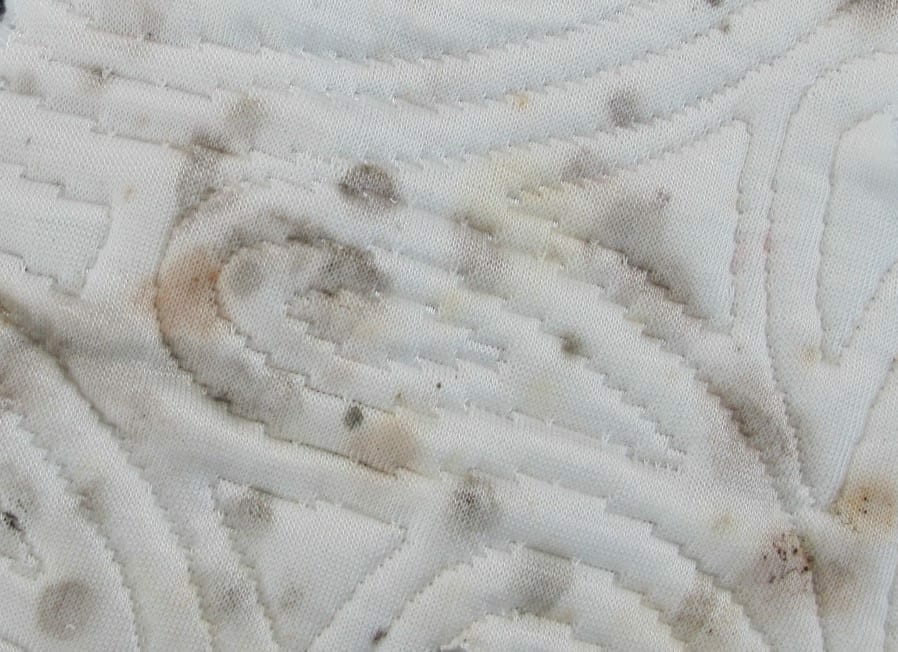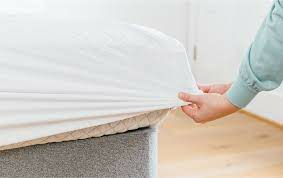As a homeowner, it’s crucial to know how to get mould out of your mattress.
Mould can develop from high humidity, lousy bedroom ventilation, spills from any liquid, and keeping your mattress on an unventilated surface – such as the floor.

When you find mould, it’s important to act quickly to prolong your mattress’s life as well as save yourself from possible health implications.
With that said, how do you get mould out of a mattress?
What Causes Mold To Form On Your Mattress?
Regardless of the mattress type you have, whether it’s memory foam, spring, or a hybrid mattress, exposing them to specific conditions will allow mould formation.
Some of the conditions that allow the development of mould include:
- Darkness. For mould to thrive, light is not one of its essential requirements. Most types of mould thrive well in dark conditions that are moist and warm.
- Humidity. Mould can start to develop on moist surfaces within 24 to 48 hours. Relative humidity above 70% indoors is ideal for mould to thrive.
- Warmth. For mould to thrive, temperature plays a big role in mould development. Between 77° F and 86° F plus a humid environment enables mould growth.
Sadly, all these can be present in mattresses, especially if a bedroom lacks proper ventilation.
The most prominent parts of the mattress prone to mould growth include the bottom surface and the top side that connects to the bed frame.
Items you need when cleaning mould on a mattress.
- Hand-held vacuum
- Electric fan
- Protective gear (goggles, mask, rubber gloves)
- Small bowl or basin
- Spray bottle
- Cloth or towel
- Isopropyl (rubbing) alcohol
- Warm water
7 Effective steps on how to get mould out of mattress
Once you notice apparent mould growth on your mattress, it’s important to take quick action. Follow these steps to get mould out of your mattress.
Step 1. Remove Your Beddings & Wash In 60+ Celcius Water
Strip all beddings from the mattress. When you have mould stains on your sheets, wash in hot water with laundry detergents plus Clorox or OxiClean. Air dry the sheets under the sun.
Step 2. Vacuum The Surface Of The Mattress
Position the mattress against the wall and vacuum all surfaces. After you’re done on one side, flip the mattress over to cover all areas.
Step 3. Prepare your cleaning solution
Prepare a solution that contains equal amounts of isopropyl (rubbing) alcohol and warm water. Mix both ingredients and pour them into a spray bottle. The amount you’ll prepare will depend on how significant the mould growth is on your mattress.
Step 4. Apply the solution by spraying it directly on areas with mould growth
Try to spray evenly on surfaces with evident mould growth. Remember that even if you find mould on the surface, it’s likely to have grown extensively within the mattress.
Step 5. Perform manual rubbing on the stain
Dip a cloth or towel into the alcohol solution. Rub on areas with mould growth in circular motions, focusing on stubborn stains. As much as possible, rub and scrub the site with enough force you can muster. Once the areas are free of stains, dip the cloth in clean water to rinse the site.
Step 6. Leave the mattress to dry
Allow the mattress to dry under the sun or with an electric fan. If the weather looks good, it’s best to dry the mattress outside. If possible, perform the cleaning task early in the morning to ensure enough exposure so it dries thoroughly. Make sure to flip the mattress halfway to ensure it receives equal exposure to the sun.
You can dry the mattress indoors with an electric fan if the weather doesn’t allow it. The area where you’ll dry the mattress should have good ventilation. Remember to use a dehumidifier along with the electric fan. Check the mattress from time to time to ensure it’s thoroughly dry. If in doubt, leave it to dry longer.
Step 7. Clean the site
The area where you cleaned the mattress requires thorough vacuuming and cleaning. Remember that the spores can readily spread. With this in mind, all surfaces that come in contact with the mattress must be thoroughly clean.
Pay close attention to the bed frame or the base of the bed. Once the mattress is completely dry, place it back on its base, and you can place clean sheets.
7 Ways to prevent mould on a mattress
The development of mould on your mattress poses a health risk, triggering both short and long-term health conditions.
1. Use a mattress protector.
A mattress protector is a surefire way to ensure your mattress is protected at all times from spills, urine, and bodily fluids. The extra layer will work effectively in protecting against moisture.

2. Clean and dry spills right away
Water spills should be dealt with as soon as they happen on your bed. Stack paper towels closely together to absorb as much water as possible. If it’s plain water, dry the site under a hair dryer or electric fan.
If it’s a beverage, you must prepare a solution comprising one part laundry detergent and two parts warm water to clean the site and let it dry.
3. Use an elevated bed base.
Consider getting a suitable bed base if your mattress rests directly on the floor. Allowing the mattress to remain in this state will put it at a high risk of developing mould.
The purpose of the bed base is to allow air to flow onto the underside of the mattress. Remember that it’s the side that moisture is likely to build up and make it hard to escape. Make sure that the base the mattress will rest on is breathable.
4. Use a dehumidifier
Mould thrives in moist or damp conditions. Mould is likely to grow in conditions with relative humidity above 70% indoors for prolonged periods.
The ideal approach to limiting mould growth is regularly using a dehumidifier to keep the humidity levels low. Investing in one may be best, especially in areas with high humidity levels. Generally, you only need to use a dehumidifier at night.
5. Maintain adequate ventilation in your bedroom
Allow the air in your bedroom to circulate if you’re not around. The simplest approach is to open the windows to allow natural air to flow freely as long as the weather permits. Remember that both the mattress and your bedroom need to breathe.
6. Avoid drinking or eating in bed.
If you occasionally eat while in bed, consider letting go of the habit. You must deal with the stain and odour if you accidentally spill your beverage. Although minor spills might not deeply sink into your mattress, the environment it creates might allow mould to develop soon.
7. Allow the mattress to fully dry.
After cleaning the mould stains on your mattress, make sure to allow it to completely dry before using it again. Doing so ensures that there’s no lingering moisture that can trigger another round of mould growth.
What are the signs of mattress mould?
Early mould growth on a mattress isn’t usually visible to the naked eye. Still, if you want healthy and uninterrupted sleep, it’s important to notice the telltale signs.
Here are some of the usual signs of mould growth on a mattress.
- Unusual odour. Mould spores have a musty smell, while the mould releases a pungent odour resembling rotting food. Once the mattress starts to smell odorous, mould is likely growing. A mattress will often start to smell bad before any visible stains show.
- Greenish or bluish blotches. The presence of stains tells that you have mould growth on your mattress. As the fungus proliferates, it leaves behind greenish or purplish blotches on the surface.
- Allergy symptoms. Once you develop allergy-like symptoms, you have been exposed to mould for some time. If the symptoms worsen every time you are on the bed and subside during the day, it indicates a mouldy mattress.
Is it safe to sleep on a mattress with mould?
Once mould develops on your mattress, sleeping on one is not hygienic. Avoid sleeping on your mattress with potential mould growth since it can affect your health and trigger respiratory and skin problems.
If possible, avoid sleeping on a mattress if there’s a high chance that it’s infected with mould. Doing so can put you at risk for short- and long-term health conditions. With this in mind, removing the mould or replacing your current mattress with a new one is important.
Some common physical symptoms of mould exposure include wheezing, persistent cough or cold, congestion, watery or itchy eyes, headache and aggravated allergies. Prolonged mould exposure can trigger skin rashes or even asthma in sensitive individuals.
Can I use bleach to eliminate mould on a mattress?
Generally, a solution of alcohol and water is recommended when dealing with mattress mould. Another alternative you can use is bleach by applying and scrubbing on areas with mould spots. However, bleach can give your mattress a strong odour that can be hard to eliminate.
Make Your Mattress Mould-Free
To ensure you have a hygienic and mould-free mattress, it’s crucial to provide proper care. Doing so will ensure your mattress will last for years.
If you want to prevent mould growth on your mattress, knowing the causes, steps to get mould out of mattress, and preventive measures will go a long way in keeping your mattress clean and mould-free for years to come.





